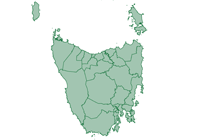A goal of economic development is often to maximise the employment opportunities locally, leading to a more socially and environmentally sustainable community.
Employment capacity is a simple way of looking at whether Break O'Day Council area could theoretically provide jobs for all its residents if they were to choose to work locally.
Employment capacity is simply the number of local jobs in an industry, divided by the number of local residents employed (anywhere) in that industry. A figure over 1.0 means there are more jobs available than residents employed in that industry. Under 1.0 means there are more residents employed than jobs available in that sector.
This is a theoretical exercise as, even if there are enough jobs provided locally, there will always be some people who choose to commute out of the area.
Employment capacity data should be viewed in conjunction with Employment self-containment and Residents place of work data, which provides detail about the actual proportion of residents working locally, and Gross Regional Product and Worker productivity data which shows the economic contribution of residents and workers.
Data source
National Economics (NIEIR) - Modelled series
Current area:
Comparison year:
| Employment capacity by industry | |||||||||
|---|---|---|---|---|---|---|---|---|---|
| Break O'Day Council area | 2022/23 | 2017/18 | |||||||
| Industry | Local jobs | Employed residents | Ratio of jobs to residents | Local jobs | Employed residents | Ratio of jobs to residents | |||
| Agriculture, Forestry and Fishing | 264 | 256 | 1.03 | 237 | 248 | 0.96 | |||
| Mining | 384 | 156 | 2.46 | 208 | 68 | 3.05 | |||
| Manufacturing | 123 | 177 | 0.70 | 129 | 148 | 0.87 | |||
| Electricity, Gas, Water and Waste Services | 49 | 57 | 0.87 | 32 | 34 | 0.96 | |||
| Construction | 220 | 236 | 0.93 | 168 | 186 | 0.91 | |||
| Wholesale Trade | 21 | 23 | 0.89 | 17 | 28 | 0.61 | |||
| Retail Trade | 277 | 262 | 1.06 | 248 | 248 | 1.00 | |||
| Accommodation and Food Services | 283 | 255 | 1.11 | 233 | 239 | 0.98 | |||
| Transport, Postal and Warehousing | 93 | 100 | 0.94 | 80 | 81 | 0.98 | |||
| Information Media and Telecommunications | 0 | 50 | 0 | 28 | 41 | 0.70 | |||
| Financial and Insurance Services | 13 | 11 | 1.19 | 13 | 10 | 1.28 | |||
| Rental, Hiring and Real Estate Services | 45 | 43 | 1.06 | 37 | 36 | 1.02 | |||
| Professional, Scientific and Technical Services | 119 | 119 | 1.00 | 70 | 72 | 0.98 | |||
| Administrative and Support Services | 119 | 98 | 1.21 | 83 | 90 | 0.91 | |||
| Public Administration and Safety | 118 | 131 | 0.90 | 101 | 109 | 0.93 | |||
| Education and Training | 175 | 206 | 0.85 | 162 | 168 | 0.96 | |||
| Health Care and Social Assistance | 364 | 412 | 0.88 | 252 | 272 | 0.93 | |||
| Arts and Recreation Services | 31 | 47 | 0.65 | 26 | 28 | 0.95 | |||
| Other Services | 61 | 54 | 1.12 | 60 | 63 | 0.96 | |||
| Total industries | 2,758 | 2,691 | 1.02 | 2,184 | 2,168 | 1.01 | |||
Source: National Institute of Economic and Industry Research (NIEIR) ©2024. Compiled and presented in economy.id by .id (informed decisions). NIEIR-ID data are adjusted each year, using updated employment estimates. Each release may change previous years’ figures.Learn more. Please refer to specific data notes for more information | |||||||||


